|
GREETINGS FROM OUR SOLAR POWERED OFFICE: Hello folks (this is Chris
Daum, owner, here): Another year has come and gone, and I am happy to
report that I have had installed the system of my dreams...FINALLY….more
details below!
For those of you who aren’t “on line”, or are beginning your project, we
have an extremely informative Product Catalog on disc for $10 ($20 out
of country)—essential for your energy library! Products, system sizing,
pricing, components, importance of energy efficient appliances, battery
care, and wind turbines are just some of the topics covered. If you are
on-line, you can see example systems at www.oasismontana.com/systems.html.
To assist your information input, we’ve tried to develop as much on-line
information as we can. For solar water pumping, see www.PVsolarpumps.com;
for utility-tied photovoltaic systems, visit www.grid-tie.com; for
efficient AC appliances, DC ’fridges, coolers and freezers see
www.eco-fridge.com; for natural and LP gas appliances, see
www.LPappliances.com; we now offer composting toilets at
www.eco-potty.com and our main page is www.oasismontana.com. Visit our
web pages and stay a while! Or send us an e-mail and get on our e-list
for the latest technology information and pricing specials.
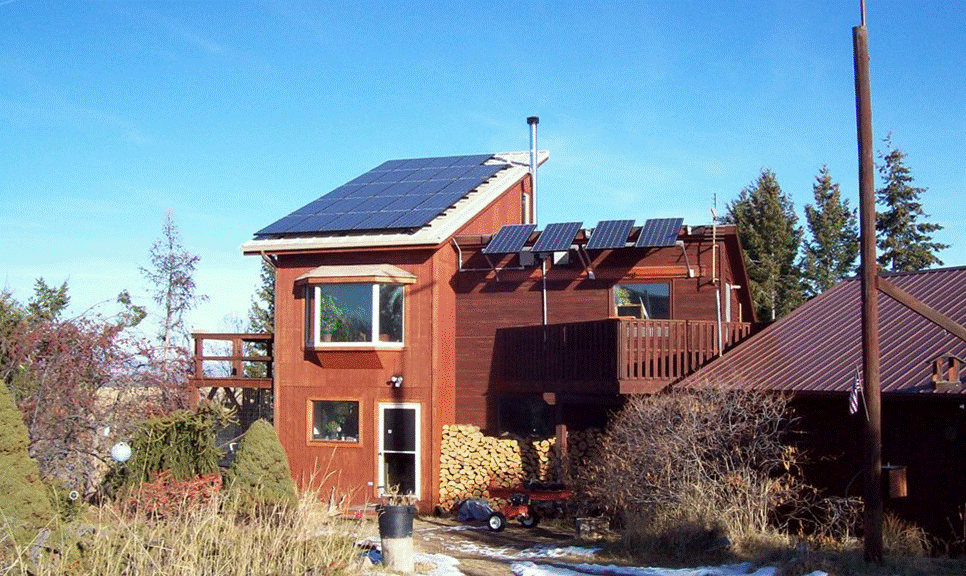 |
|
In mid-December the Oasis Montana staff completed the major system
upgrade at Chris Daum’s home/office; the eight 60W solar modules and
2500W 24V inverter were replaced by twenty-eight Sanyo 205W solar
modules, an 8KW 48V Radian inverter (new from Outback Power), and two
Midnight Solar Classic Charge Controllers. The system can effectively
run the entire place, including the 1.5HP 240VAC water pump, and when
the sun is shining, still have power to feed back to the utility. In the
event of a power outage the system works fine in an independent fashion,
since the inverter is able to feed power back as well as act as a
stand-alone inverter for remote power systems. “If I wanted to add a
generator to this set-up, I could do that too”, states Ms. Daum, “but
right now, in times of low light, th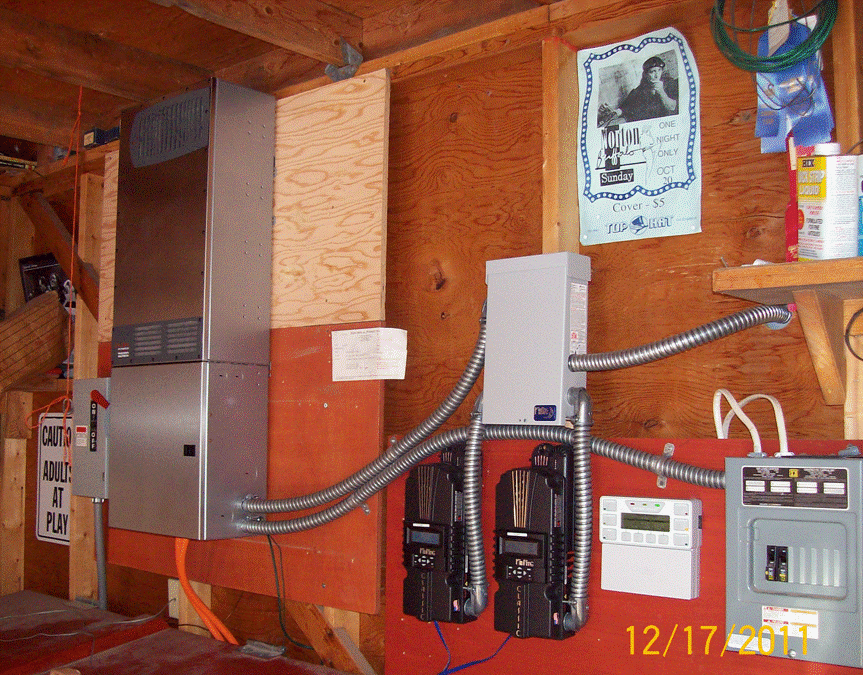 e
utility grid is my back-up as needed, instead of a generator that might
be used in a remote system.” e
utility grid is my back-up as needed, instead of a generator that might
be used in a remote system.”
There’s really not a module missing at the top (right) of the main
array; there’s a plumbing vent there as well as the morning shade of the
stove stack, so a module was left out to conform to code and common
sense (you don’t want shading on your solar modules at any time, if it
can be avoided). The array configuration is seven sets of four modules
series-wired for the proper input voltage for the Classic charge
controllers.
“Initially I was going to keep my old inverter and battery set-up and
just use the Sanyo’s in a straight grid-tie (batteryless) configuration
with an SMA or Fronius inverter. Then this new inverter came on the
horizon in late summer. The more we heard about it, the more inclined we
were to give it a try; you can still feed power back when you are making
more than you are using, and it has the surge capacity to run my 1.5 HP,
240VAC water pump."
The existing batteries, sixteen Rolls/Surrette S530s, were rewired for
48V; since they are only 2 years old, they are likely to last another 8
to 10 years with proper care. “I like the idea of having backup power;
we are at the end of a utility line, and have frequent power outages, so
it’s very convenient to have seamless continuity of power if there are
any storms or line problems. And it’s really hard to put a dollar value
on that kind of reliability!”
|
Above
left, the big stainless box is the Radian inverter; the two
black components are the Classic controllers, and the other
grey boxes are the combiner enclosure and AC sub-panel. |
|
|
SOLAR MODULE
PRICING—call for
availability, freight costs, and quantities (# of modules) on
pallets for the best deal. You can’t get less than a pallet
quantity to get the pallet ‘deal’. For larger modules, pallet
quantity generally runs between 20 and 40 modules, and oft times
there are significant additional charges for less than pallet
quantities. Some suppliers charge re-boxing fees too.
| |
|
Single |
Pallet |
| Sharp |
ND-224UC1, 224W, 7.66A, 29.3V (39.1”
X 64.6”) |
$565 |
$528 |
| Sharp |
NU-Q235F4, 235W, 7.84A, 30.0V
(39.1” X 64.6”) |
$634 |
$592 |
| Sharp |
NU-Q240F2, 240W, 30.1V, 7.98A (39.1”
X 64.6”) |
$702 |
$656 |
| |
Sharp Modules are made in the USA |
|
|
| Sanyo |
195
Bi-facial , 195W, 3.5A, 55.8V (51.9” X
34.6”) |
$960 |
$900 |
| |
HIT 205W,
5.05A, 40.7V (62.2” X 31.4)
|
$599
|
|
| |
HIT 220W,
5.17A, 42.7V (62.2”X31.4”) |
$657 |
$614 |
| |
HIT 225W,
5.21A, 43.4V
(62.2”X31.4”) |
$781
|
$732 |
| |
Sanyo
solar modules meet qualifications for Buy American
Program. |
|
|
| Samsung |
LPC244, 244W, 7.97A, 30.7V (64.2” X
38.7”) |
$518 |
$484 |
| Schott |
Poly 230, 230W, 30V, 7.66A (66.3” X
39.1”) |
$414 |
$399 |
| |
Made in Albequerque, NM. Other size
modules also available, call for more info. |
|
|
| Trina Solar |
TSM185DA01 185W, 4.9A, 36.80V
(62.24” X 39.05”) |
$487 |
$454 |
| |
TSM225PA05 225W, 7.5A, 29.80V
(64.96” X 39.05”) |
$504 |
$470 |
| |
TSM230PA05 230W, 7.66A, 30.00V
(64.96” X 39.05”) |
$542 |
$506 |
| |
TSM235PA05 235W, 7.75A, 30.30V
(64.96” X 39.05”) |
$572 |
$534 |
| |
TSM240PA05 240W, 7.84A, 30.60V
(64.96” X 39.05”) |
$587 |
$548 |
| Suntech |
180/24, 180W, 4.98A, 35.6V (62.20” X
31.81”) |
$300 |
$286 |
CANADIAN SOLAR
(more sizes available,
call for information) |
CS6P-240M, 240W, 30.2V, 7.95A (64.5”
X 38.7”) |
|
$389 |
| Lumos
|
LS235 Poly, 235W, 34.1V, 6.9A (65” X
39.1”) |
|
$489 |
| |
The LS Series is made in the USA;
Lumos offers less expensive, high quality Chinese-made
modules too) |
|
|
| Solarworld |
235W, 6.22A, 26.6V (39.4” X 65.94”)
|
$649 |
$629 |
|
KYOCERA |
KD240GX-LPB, 240W, 29.8C, 8.06A
(65.4” x 39”) |
$505 |
$490 |
| |
KD215GX-LPU 215W, 8.09A, 26.6V
(59.1” X 39.0”) $455 $440 |
$455 |
$440 |
| |
KD135GX 135W, 7.63A, 17.7V (59.1 X
26.3”) |
$385 |
$369 |
| |
(Some Kyocera modules may have a 2-3
month lead time) |
|
|
| |
KS20, 20W, 16.9V, 1.20 A (20.47” X
13.85”) |
$161 |
$158 |
| |
KS10, 10W, 16.9V, 0.60A (11.96” X
13.85”) |
$113 |
$110 |
| |
KS5, 5W, 16.9V, 0.29A (8.07” X
13.85”) |
$84 |
$74 |
| |
Modules manufactured in Kyocera’s San
Diego facility qualify for Buy American Program. |
|
|
| Conergy |
180M 180W, 5.0A, 36V (62.2” X 31.8”) |
$332 |
$310 |
| |
Triple Black235PH 235W, 8.06A,
29.20V (65.0” X 39.1”) |
$424 |
$396 |
| |
235PH 235W, 8.06A, 29.2V (65.0” X
39.1”) |
$377 |
$352 |
| |
240PH 240W, 8.13A, 29.5V (65.0” X
39.1”) |
$391 |
$365 |
| |
PowerPlus225 225W, 7.74A, 29.23V
(65.0” X 38.8”)
(PowerPlus 225s are ARRA compliant!) |
$434 |
$405 |
|
HELIOS |
6T 250, 250W, 30.3V, 8.22A (66.1” X
39”) |
$482 |
$450 |
| |
Made in Milwaukee, WI, USA! Other
Helios modules available, call for more info. Due to
the possibility of the Chinese import war, call for
current pricing information—prices subject to change
without notice. |
|
|
NEW!
EcoSolargy Alpha 185 |
185W, 36.2V, 5.14A (62.2" x 31.8") |
$300 |
$285 |
|
Outback Energy Cell Battery System: As the
demand for renewable energy increases, the needs of system
integrators and installers are rapidly evolving as well. OutBack
Power is responding by engineering its acclaimed line of BOS
(balance-of-system components) into preassembled systems to give
installers the best of both worlds: OutBack quality in a more
easily specified and installed package.
The OutBack Integrated Battery Rack system is a comprehensive
battery enclosure solution with cell interconnects, cabling, and
series string overcurrent protection and disconnects included,
making it easy to order and install. All electrical connections
are made at the factory and ship fully assembled with the
exceptio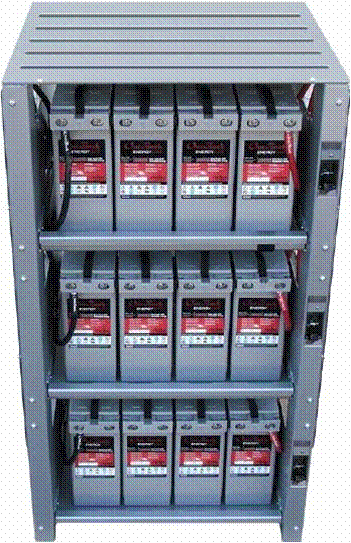 n
of the batteries, which can be quickly added and connected on
the jobsite. n
of the batteries, which can be quickly added and connected on
the jobsite.
Pair this up with a set of Outback’s new Energycell RE batteries
for a simple and robust back-up system. The EnergyCell RE
valve-regulated lead acid battery is designed for high power
density and renewable energy cycling applications, with Absorbed
Glass Matt (AGM) technology for efficient gas recombination of
up to 99% and freedom from electrolyte maintenance. The
EnergyCell RE also features low profile terminals with threaded
copper alloy inserts providing reduced maintenance and increased
safety. Best of all is this new battery system outperforms and
costs less $/Ah than other comparable systems. Call for more
information, 406 777-4309.
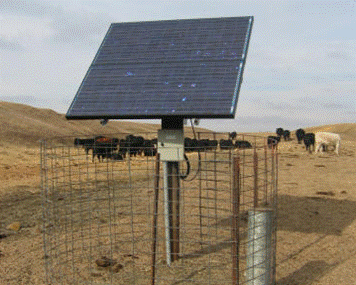 Solar water pumping Solar water pumping
season is fast approach-
ing. If you have thirsty
cattle, a remote cabin,
are protecting riparian
areas, drip irrigating your garden, or want to keep your pond
topped off, call our system designers. We have water pumping
systems all over the world! Please answer all the questions on
our web page at www.PVsolarpumps.com so we may determine the
best components for YOUR solar pumping project.
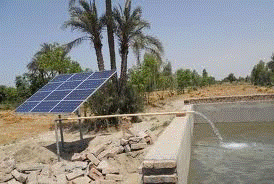 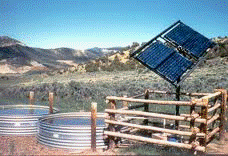 |
|
|
|
WHO WE ARE and ORDERING INFORMATION: Chris Daum,
owner and manager of Oasis Montana, has been in the renewable energy
field for 23 years. Our staff offers experience,
personalized service, tech support, quality components and good pricing. We are happy to work with your installer, electrician, or contractor,
and locally we can install your power system (or even fly to your site
for installation). We provide detailed wiring diagrams with the systems
we sell. TO PLACE AN ORDER: E-mail or call us for your freight; if you
have any questions about your system or product, please contact us.
E-mail is easiest and fastest (but we know that you aren’t all on line).
We accept Visa/Mastercard (personal and business checks are fine). For
our international customers, we accept bank transfers— e-mail or call us
for our banking information. Our hours are 8:00 am to 4:30 pm Mountain
Time, Mon. – Fri. If we‘re on another line when you call, please leave
us a message, and we’ll get back to you as soon as we can, but you may
have to leave a message if we’re with a customer or on one of the other
lines. 406-777-4321 or 4309 or e-mail us at info@oasismontana.com — for
tech support on renewable energy systems, e-mail larry@oasismontana.com. We’d be very happy to
help you with your power project — send an e-mail or give us a call!
|
|
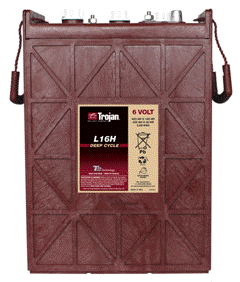
The
Importance of Battery Monitoring: With any solar power system,
understanding how the system is performing is essential for protecting
the owner’s investment. If the system is battery-based, being able to
monitor the batteries’ level of discharge is important since batteries
are generally the weak link as well as very costly. Many off-grid owners
develop a skill called ‘load management’, which means you are conscious
of when you turn off appliances and multiple loads together, especially
during times when the sun is not shining much or the gas-powered
generator is not running.
Most off grid systems use a digital meter to automatically set a
predetermined low voltage setting that can turn on a gas-powered
generator to make sure that your batteries never go below a certain
percentage of discharge. The level of discharge will vary from owner to
owner, determined by how often (or little) they want to run their
generator or by how much sun is available in the area. Often discharging
the batteries 50% is common for owners, but many will recharge after the
batteries have discharged only 20%. The 20% level is often used when
the battery bank is grid-tied, which allows for recharging from the grid
and is cheaper than burning propane, diesel or gasoline in order to run
the generator for charging. If a system owner is using a Magnum Energy
inverter then they need to invest in an auto gen start (AGS) that works
with the remote digital meter. The remote meter has the AGS settings in
the meter and the auto start uses these settings to start the generator
automatically when a certain low voltage set point has been reached.
Outback has the AGS set points built into their MATE system monitor as
well, which activates a relay switch to turn on the generator. In
addition, the MATE has many more charging set points to work with,
making it both more complex and advanced then the Magnum’s AGS.
Fortunately, the new MATE 3 that Outback Power has developed is more
user-friendly than the original MATE models by using more icons and
having easy-to-use buttons dedicated to a variety of functions.
Often with small modified sine wave (or square wave) inverters that
still have a built-in AC charger, the inverter does not have a meter;
instead it has knobs on the inverter used to adjust the charger's set
points. Unless the owner uses the stand alone AGS that Magnum
offers (which monitors battery voltage on its own without relying on a
digital meter) the owner will have to manually start the generator. So
the owner still needs a meter of some sort in order to know what is the
batteries' state of charge. In this case, the most common meter is made
by Bogart Engineering, and is called a TriMetric meter. Many people use
the TriMetric meter as a back up in order to make sure the main system’s
meter is accurate. There are a few options with TriMetric meters; the
original is called a TM-2020 and is used with 12-24 volt systems. Since
48 volt systems are more common today, Bogart has come out with the
TM-2025A which can be used on systems from 12 to 48 volts. For the
system owner who needs more capabilities than the Trimetric offers there
is the PentaMetric meter. This meter can monitor one or two systems at
the same time using a common negative. When only one system is used it
can show battery current plus two charging sources/loads. It is also
possible to interface the PentaMetric with a computer for remote
monitoring.
No battery system should be expected to function properly without some
form of monitoring system. Often with grid tie systems, the
monitoring equipment is an added expense and people decide to omit to
save a few bucks. Luckily, grid-tie systems are so turn-key the
owner is able to get by without knowing the system's output. The
downside to this is if they do have a problem they usually do not know
about; and thus end up paying for utility power while the PV system that
they have purchased fails to do its job properly. With an off grid
system, battery monitoring is essential for maintaining the system’s
health and without it, the owner will likely be disappointed in the
short lifespan of his or her battery bank. Having some form of
monitoring device for your system is key to understanding your system's
capabilities (or limitations) and helps the owner interact with their
system, leading to greater battery longevity and better
performance. Not having a battery monitor to give you your system's
information is very much like driving a car without a working gas gauge!
It is worth the investment in a decent battery monitor to protect the
integrity of the heart of your system--the batteries. If you have any
questions about a battery monitor, call us at (406) 777-4309.
|
|

Tri-Metric Meter and Diagram
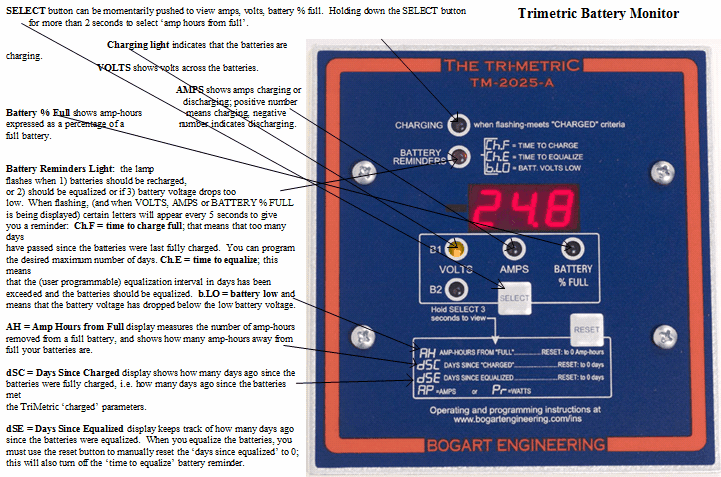
 |
|
COMING APRIL FIRST: Peerless Premier Cordless DC Ranges:
Beginning April of 2012, the Department of Energy has banned the
production of standing gas pilot ranges in the USA. These new ranges
from Peerless will have a DC electronic ignition system that will
operate off of a battery pack consisting of eight double A batteries,
and those will last at least 3 to 4 years (and, according to their
tests, perhaps as long as 7 or 8 years). They will give an audible
signal when the batteries start to get low, but will continue to operate
for some time after that. There will be a small overlap period for the
changeover in production, and the standing gas pilot ranges will
continue to be offered until they are out of stock. If your preference
is a standing gas pilot range, you should order yours
now. But, these DC ranges do
offer some benefits compared to standard gas pilot ignition ranges,
including enhanced safety, convenience, energy savings, and the ability
to work in the absence of AC power or during power outages.
There will be a total of six Premier Cordless
Ranges that will be introduced and supported accordingly, comprised of
the best-selling range sizes in the current Premier range line up.

|
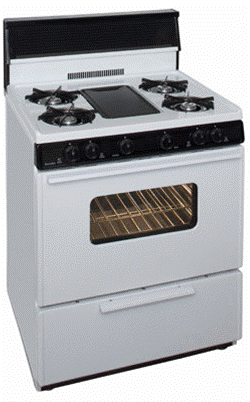
Model # BFK5S9WP, 30" Width |
While we do not have
confirmed prices on these upcoming models, the 30” range, left,
the BFKS9WP, is likely to
cost $680 before freight. A 36” wide fifth burner model with
this style will also be available, the BLK5S9WP, and its cost
will be $720 plus freight. Top burners are 9100BTU; middle
burner can either be a cast aluminum griddle or another burner,
and there’s also a cover if you do not need the burner. Oven
burner is 17000 BTU. Backguard is 10” tempered glass and chrome
heat reflector trays are included. All these stoves’ cooktops
are porcelain finished for longevity and ease of cleaning.
|
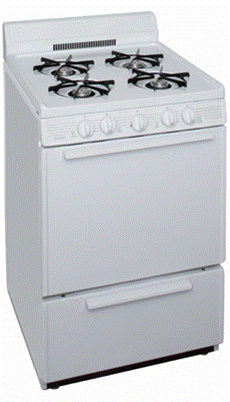
Model # BCK100OP, 24" Width |
These simpler stove models
have a 4” porcelain backguard; the 36” models have a side
storage space. The
20” wide BAK100OP will be
$485; the 24”
BCK100OP
(pictured at left) will be $520; BFK100OP is the 30” model,
$545, and the 36” model BLK100WP will be $620 plus freight.
These DC ignition stoves are
available in the open burner style only. These units come set
up for natural gas, but all models include information for easy
LP conversion. Note: there is no interior light in the ovens
on these stoves. All of these gas ranges adhere to the federal
mandates driving the industry-wide changes impacting standing
gas pilot ranges.
|
|
|
You can view our entire appliance line at
www.LPappliances.com
|
|

To track or not to track.
. .
Since the advent of the solar module, people have been trying to find
out ways to make their arrays more efficient so they could harvest as
much sun energy as possible. Some of these innovations have included
reflecting mirrors, magnifying lenses, concentrators and cooling
systems. Perhaps the most effective of these has been the solar tracker.
Since a solar module will provide the most power when the sun’s rays are
striking the cells perpendicularly, it would make sense that if you
optimize the amount of time they are in that orientation the greater
your power production. A solar tracker does just that, it “aims” the
solar array at the sun and continues to track it throughout the day.
Some trackers produced today use electric motors to change the
orientation while others such as the Zomeworks Tracker use a passive
system that relies on the weight-shift of refrigerant gas within its
rail tubes to pivot the rack. It has been found that these trackers can
increase your system’s capacity by upwards of 35% in summer, which in
turn leads to a smaller array size and thus a reduced system cost. In
winter, the gains are much smaller.
Recently though, the latter benefit may be shifting. With solar module
prices plummeting down below $2.00 per watt and the costs of metal on
the rise, we have been finding that in many cases it is making more
sense economically to steer away from the trackers and lean more towards
simply increasing the system capacity. In other words instead of using a
tracker to increase your output by 35% it now costs less to leave the
array fixed and just to increase the installed capacity by 35%. It will
not only pencil out less expensive, but it will also give you peace of
mind that there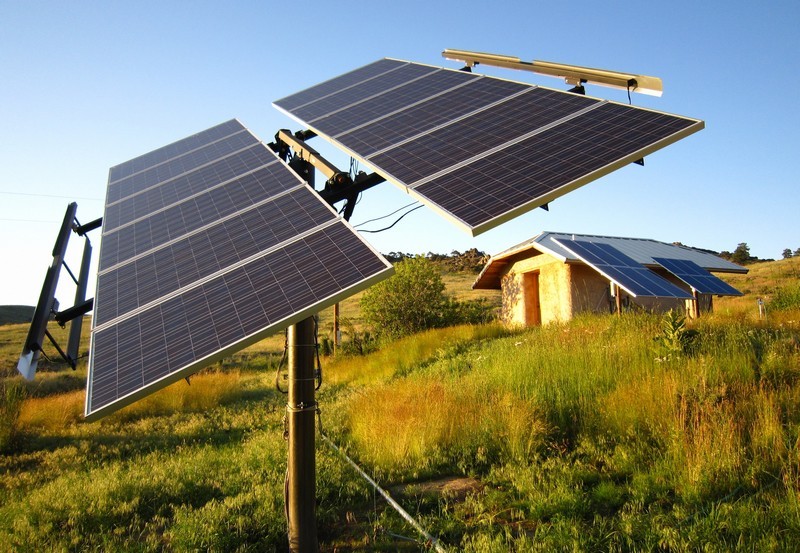 are no motors or moving parts that may require
maintenance or replacing. Another thing to keep in mind when planning a
grid tied PV system is that many rebate programs are set up to give you
back a certain dollar- per-watt of installed capacity. If you were to
install a tracker with a smaller array -- your rebate would be smaller
as a result. are no motors or moving parts that may require
maintenance or replacing. Another thing to keep in mind when planning a
grid tied PV system is that many rebate programs are set up to give you
back a certain dollar- per-watt of installed capacity. If you were to
install a tracker with a smaller array -- your rebate would be smaller
as a result.
That being said, there are times when trackers do still make sense in
the design of a system — one being if you simply need an array with less
square footage of modules. Other advantages come into play typically
when dealing with solar water pumping; for example: if you have a low
producing well and want to pump as much water as possible from it in one
day without pumping it dry. In this case a tracker will help the pump
operate at its maximum potential for the better part of the day, rather
than a fixed system which will start slowly, peak at mid day and then
taper off.
Hopefully, new innovations with trackers will again shift them back into
the spotlight, because let’s face it, they are pretty cool!
If you think you have a situation where you think a tracker would suit
you, give us a call to see what model works best for your project; you
can also view info at
www.oasismontana.com/zomeworks.html.

|
|
THE IMPORTANCE OF ENERGY EFFICIENCY (or, the cheapest power
is that which we do not use!)
We just keep throwing it away. Energy that is—we keep throwing it away
like litter along the highway. A little air leak here, a power strip
that we never turn off, the draft that never gets sealed, idling our
vehicle longer than we need for warm up, bumping the thermostat up
another 10 degrees to knock the chill off—any number of ways that we
just keep loading the atmosphere with our wasted heat and power.
Fortunately, one of the prime things that we encourage our customers to
accomplish is energy conservation. For those considering the switch to a
renewable energy source it can make the difference between affordable or
not. When we own our own power plants, we become much more mindful of
where our energy dollars go. Since component costs are relatively high,
we have a tendency to conserve power wherever we can! Another module at
$400, a larger inverter, two more batteries...it quickly makes
economical sense to conserve power.
It’s funny, when I was talking to a client this week about their home,
they were laughing when they told me that most people never knew that they were off the grid! There really isn’t any difference regarding the
source of electricity--power is power and the source just doesn’t matter
to the refrigerator, microwave or light bulb: as long as it is available
and the right voltage/frequency, the appliance will run. Energy
conservation is easy, simple and cheap. Getting started is probably the
most difficult step in the entire process. There are so many ways that a
person can go—getting started on one of the paths will allow the next
path to be followed when the time comes.
they were off the grid! There really isn’t any difference regarding the
source of electricity--power is power and the source just doesn’t matter
to the refrigerator, microwave or light bulb: as long as it is available
and the right voltage/frequency, the appliance will run. Energy
conservation is easy, simple and cheap. Getting started is probably the
most difficult step in the entire process. There are so many ways that a
person can go—getting started on one of the paths will allow the next
path to be followed when the time comes.
Let’s start simple. If you see a piece of paper—pick it up. This is a
simple start for a litter problem and you can be just as simple with
your energy conservation. If you see an unneeded light on—turn it off!
Use of Compact Fluorescent or LED Lights is another great way to reduce
the energy that you are using in your home or business. If you aren’t
sure just what that old beast of a refrigerator is pulling for an
electrical load, we at Oasis Montana have a great little inexpensive
monitoring tool called a “Kill-a-Watt” meter that will let you know what
any appliance in your home or business is using for energy. Wouldn’t it
be great to be able to walk in to an appliance store and know what you
are presently spending in energy use when you look at those fancy yellow
stickers with the “Energy Star” ratings?
Some people are already well on their way to understanding where their
energy dollar is being thrown away or spent. Those folks have started on
the path to conservation and simply need an idea on where to go next.
Here are some idea’s: insulation is always a great move; “R” rating
means the insulation’s resistance to heat flow. When you go from an R-5
to an R-49 in your ceiling you not only hang on to the heat longer, your
heating requirements are lessened. Another thought that can help quite a
bit is to seal the air distribution ductwork on your forced air furnace.
By some estimates we loose over 30% of our heated or cooled air through
leaks in our ductwork. Duct tape isn’t going to work, you need to use
that sticky-comes-in-a-can stuff that you paint on with a brush. Once
you have sealed your ductwork be sure to insulate it with a jacket of
R-5 to R-8 insulation. As long as you are going to be heating or cooling
the air, you may as well have the heat or cold that you are paying for!
Otherwise you are throwing it away.
Some folks consider the idea of window replacement as a great investment
move--and it might or might not be. There are some perfectly adequate
windows in buildings and homes now that would have a better First Dollar
spent somewhere else. Sealing a building to limit the natural air
turnover rate to four times an hour may be a better investment. When you
are getting serious about energy conservation it may be a good idea to
ask for an energy audit from your utility. These are generally free to
customers and can provide a good direction to start. For a nominal
fee—generally around $250~$400, you can have a local energy audit
company come to your home and they will provide you with recommendations
on which energy conservation strategies would be best for you to employ.
These audits will typically use a blower door test with an infra-red
camera to spot points in your building that are leaking air (heat).
These tests may include the use of a Duct Blaster to gauge the air
tightness of your ductwork also. If you are seeking an energy audit
company, be sure to ask if they are RESNET certified (http://www.resnet.us/).
This will assure that they employ the latest techniques and practices in
making sure that your home or building has the correct amount of
ventilation, your natural gas or propane appliances are correctly
adjusted, and help you to ascertain next best steps for you to take.
There are plenty of energy conservation ideas out there and we at Oasis
Montana are more than willing to share some thoughts and concepts. We
would love to sell you a power generating system that will meet your
present consumption but that might not be the best for you. We may be
able to reduce the amount of energy that you are using and wind up with
a lot smaller system that will still keep you powered in the winter,
cool in the summer. Ultimately it is your call; do you want to keep
throwing it away ($ka-ching$) or is it time to start putting some of
those dollars in your own pocket?
-Larry Keogh

|
|
Find out what solar incentives are available in
your state at http://www.dsireusa.org
|
|

Kill-A-Watt Meter:
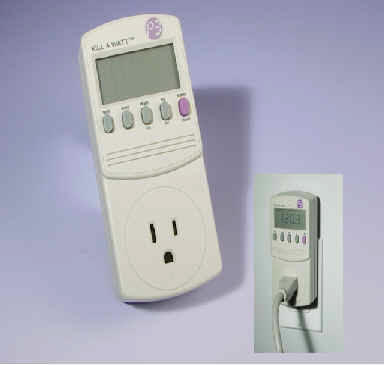
This electricity detector and monitor can educate you about your monthly
electric bill and help you save a lot of money. You can now be a
’detective’ and ascertain what appliances are actually worth keeping
plugged in. Simply plug in the Kill-A-Watt meter, connect your
appliances to it and Kill-a-Watt will assess how efficient it really is,
showing you the instantaneous power used, and also cumulative energy or
kilowatt-hours used.
Kill-a-Watt, with an easy-to-read LCD display, will count consumption by
the kilowatt-hour, same as your local utility. With the help of
Kill-a-Watt you can figure out your electrical expenses by the day,
week, month or year on a given device. Kill-a-Watt can check the quality
of your power by monitoring Voltage, Line Frequency, and Power Factor.
NEW PRICE of $25.
Now you'll know if it is time to install a power strip on your
entertainment center instead of feeding those ghosts loads while you are
sleeping or away from home. Or, is that laptop really cheaper to power
than a desktop PC? And how much power does that HD TV use?
Operating Voltage: 115VAC Max Voltage: 125VAC
Max Current: 15A Max Power: 1875W
Dimensions: 5 1/8” x 1 5/8” x 2 3/8”
Still $29 plus shipping.

|
|
Renewable Energy and Alternative News Bites:
--Denmark aims to
be fossil fuel free by 2050, with half of their electricity derived from
wind power by 2020 and relying on biomass and biogas for the rest.
http://www.winddaily.com/reports/Wind_power_to_account_for_half_of_Danish_energy_use_in_2020_999.html
--Cameroon Farmers turn dung into power:
http://www.trust.org/alertnet/news/cameroon-farmers-turn-dung-into-power/
A government program in Cameroon is helping rural livestock farmers
convert animal manure not only into fertilizer for crops, but bio-gas
for lighting, heating and cooking -- as well as a source of added
income. One farmer says she is using money from sales of excess fuel to
pay for medical care, education and animal stock.
--NREL's Electronic
Atlas Maps U.S. Renewable Energy Resources:
http://www.nrel.gov/news/press/2012/1681.html. A new
geospatial application developed by the U.S. Department of Energy's
National Renewable Energy Laboratory allows users to easily and
accurately map potential renewable energy resources in the United
States. RE Atlas is designed to facilitate energy policy development,
investment, and education by making high quality data accessible and
easy to understand. The tool creates dynamic maps of renewable
resources, including biomass, geothermal, hydropower, solar, and wind.
RE Atlas can display resources individually or in a composite fashion.
The interactive tool is free to use and available online at
http://maps.nrel.gov/re_atlas
--Negative Carbon Gasoline to be Road Tested by CoolPlanet Biofuels:
http://www.energyboom.com/biofuels/negative-carbon-gasoline-be-road-tested-coolplanet-biofuels
CoolPlanet Biofuels has received approval from the California Air
Resources Board to road test its negative carbon gasoline in California.
The company's unique negative carbon biofuels are produced by converting
low-grade biomass -- such as grass and woodchips -- into high grade
fuel. The negative carbon byproduct that comes from the process of
conversion can be used to sequester carbon and act as a soil
conditioner. The first fleet test will involve blending this negative
carbon blend with California's standard E-10 gasoline to help meet
California's 2020 goal of 10% emissions reduction. CoolPlanet has the
capability to produce over one million gallons of 2020 low carbon
gasoline this year, and projects ramping to a billion gallons by 2015
and significantly higher volumes by 2018.
--Military Leaders Want US
to Reduce Oil Consumption 30% in Next Ten Years:
http://www.sustainablebusiness.com/index.cfm/go/news.display/id/23107
Some of the highest ranking retired military leaders have released a
report "Ensuring America's Freedom of Movement: A National Security
Imperative to Reduce U.S. Oil Dependence" calling for "immediate, swift
and aggressive action" for the US to reduce oil consumption 30% over the
next 10 years. The report is by the CNA research organization's Military
Advisory Board. The analysis measured the effect of four different
theoretical blockages in the flow of oil, each lasting 30 days, in the
Strait of Hormuz, the Suez Canal, Bab el-Mandeb, and the Panama Canal.
Under a worst-case scenario, 30-day closure of the Strait of Hormuz, the
analysis finds that the U.S. would lose nearly $75 billion in GDP. But
cutting current levels of U.S. oil dependence by 30%, the impact would
be nearly zero. America must also diversify the fuels it relies on to
insulate it from the inevitable disruptions in the world's oil supply.
--Largest Solar Powered Boat in World Record Circumnavigation Attempt:
http://www.gizmag.com/tranor-planetsolar-circumnavigation-attempt/17039/
. This big boat can hold up to 40 persons and can cruise at 14
knots, but it will only have crew of six for its around-the-world
journey. - -Weatherized homes saving money for U.S. Families:
http://energy.gov/articles/weatherized-homes-saving-money-families-across-us.
The U.S. Department of Energy’s Weatherization Assistance Program has
supported the weatherization of over 750 thousand homes, including more
than 600 thousand homes through the Recovery Act, over the past three
years. On average, the program reduces energy consumption for low-income
families by up to 35 percent, saving them more than $400 on their
heating and cooling bills in the first year alone. These energy
efficiency upgrades include adding insulation, sealing ducts, and
installing efficient windows, heating & cooling systems—as well as
providing jobs and supporting economic growth.
 |
|

HOT STUFF AT THE OASIS!
We grew quite a few HOT peppers last year, some
good short-season varieties; we also still have plenty of colorful corn
seed to share. If you are interested, send us a few stamps or a
self-addressed envelope and we are happy to share our organic home-grown
seeds.

Quotable Quotes:
If we had no winter, the spring would not be so
pleasant: if we did not sometimes taste of adversity, prosperity would
not be so welcome. -Ann Bradstreet
Now 'tis the spring, and weeds are shallow-rooted; suffer them now and
they'll o'ergrow the garden. -William Shakespeare
It was one of those March days when the sun shines hot and the wind
blows cold: when it is summer in the light, and winter in the shade.
-Charles Dickens
No man's life, liberty, or property is safe while the legislature is in
session. -Mark Twain (1866)
The government is like a baby's alimentary canal, with a happy appetite
at one end and no responsibility at the other. -Ronald Reagan
The use of solar energy has not opened up because the oil industry does
not own the sun. -Ralph Nader
What’s the use of a fine house if you haven’t got a tolerable planet to
put it on? -Henry David Thoreau
We are firm believers in nuclear power. It has proven to be a reliable
source of energy in the past and will continue to be reliable in the
future.
However, we really only need one power plant to supply us. It needs to
have good distribution over most of the populated areas and easily
available to anyone. It should be a proven design with no maintenance
required and last a very long time without any upgrades or
modifications. There should be no waste to deal with and be inaccessible
to terrorists for their use. Such a power plant already exists. It is
93,000,000 miles away but, oh, so easy to hook up to… -Unknown
Sunshine is spread out thin and so is electricity. Perhaps they are the
same, sunshine is a form of energy, and the winds and the tides are
manifestations of energy. Do we use them? Oh, no! We burn up wood and
coal, as renters burn up the front fence for fuel. We live like
squatters, not as if we owned the property."
-Thomas Edison, 1910
We still do not know one thousandth of one percent of what nature has
revealed to us. -Albert Einstein
Man does not weave the web of life; he is merely a strand in it.
Whatever he does to the web, he does to himself. -Chief Seattle
The first day of spring is one thing, and the first spring day another.
The difference between them can be as great as a month. -Henry Van Dyke
I think that no matter how old or infirm I may become, I will always
plant a large garden in the spring. Who can resist the feelings of hope
and joy that one gets from participating in nature's rebirth? -Edward Giobbi
|
|
